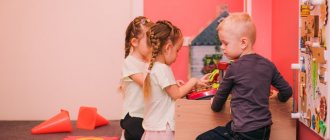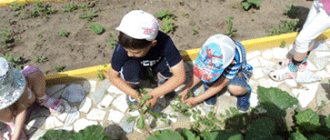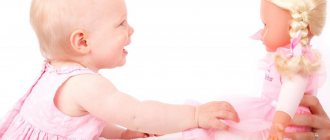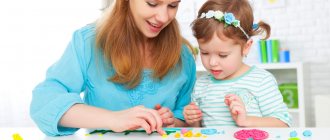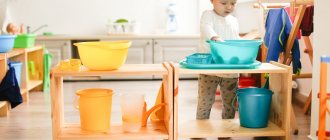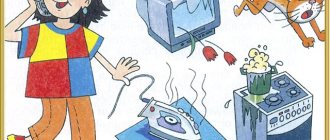In order for a child to grow up independent, it is very important to develop his self-care skills in a timely manner. This includes the ability to drink and eat independently, hygiene skills, cleaning toys and much more. At what age can you start teaching your child to take care of himself? What skills should a child learn first? How to properly develop self-care skills? What to do if a child resists independence? We will talk about this in today's article.
How to develop independence in a child: basic principles
Despite their small age, children can do a lot on their own if they are given the opportunity. But in order to develop self-service skills in a child, you will have to be patient. At first, when your baby is just beginning to master a skill, be prepared for the fact that actions that were previously performed easily and quickly with your help will take much more time. And a child who learns to use a spoon on his own will most likely get himself and everything around him dirty. But, believe me, the effort and nerves expended will definitely pay off for you a hundredfold. Gradually, the baby will do better and better, and, in the end, he will completely refuse your help. So, if you want to develop independence in your child, adhere to the following rules:
- Allow your baby to act independently;
- Praise your child for his desire to do something himself;
- Don't scold him if he does something for a long time and clumsily;
- If your child asks for help, do not refuse him.
“Help me do it myself” is a fundamental principle of the Maria Montessori system. And our task, as adults, is to create a space for the baby that meets his needs.
In order for a child to have the opportunity to express himself independently, appropriate conditions must be created at home. Things that do not pose a danger to the baby should be freely available. There are several types of independent activity of a child, the implementation of which adults can ensure through the organization of space:
- Quenching thirst (a jug and a glass of water should be freely available to the baby);
- Cleaning (let the baby have his own broom, dustpan, bucket, brush, rag, sponge);
- Caring for plants (for this you only need a small watering can and a spray bottle);
- Changing clothes (it is advisable that the baby has access to some of his clothes and shoes);
- Maintaining hygiene (so that the child can wash his hands or wash himself, place a special attack under the sink);
- Setting the table (the child needs to know where his dishes are kept);
- Cooking (your baby will be happy to help you prepare food);
Remember that by organizing a developmental space for your baby, you open up many opportunities for him to demonstrate independence, but do not oblige him to do anything.
“Formation of self-care skills in young children” Consultation for parents
«Formation of self-care skills in young children
»
Consultation for parents
Dear parents, we draw your attention to important points when developing your child’s self-care skills. Self-care skills for children aged 1.5 to 3 years include:
1. Neatness skills:
1. With a little help from adults, be able to use: a handkerchief, a towel, a pot, a comb, a napkin.
2. Notice the disorder in clothes, eliminate it with a little help from adults.
2. Eating skills:
1. Chew with your mouth closed.
2. Use a spoon (ability to hold a spoon, scoop it into food, bring it to your mouth)
.
3. Drink from a cup, holding it with both hands.
4. Take it yourself, bite off pieces of bread.
3. Dressing and undressing skills:
1. Ability to put on (take off)
various items of clothing in a certain sequence with a little help from adults.
2. Unfastening and fastening buttons, Velcro, straps, snaps, zippers on clothes and shoes with a little help from adults.
The formation of these skills does not happen on its own; they must be developed in a child from an early age. All parents understand the need to develop these skills, but do not always know how to develop these skills. We bring to your attention the simplest and most accessible techniques for interacting with a child to develop his self-care skills.
Techniques for developing neatness skills, cultural and hygienic skills
1) Show adults how to perform each action and their sequence. For example: “Look, baby, how I wipe my hands. I'll grab a towel first..."
It is very important when teaching washing techniques and cleaning toys to keep the same method, the same sequence of actions unchanged. There is no need to be afraid to show and explain to the child several times what and how to do.
2) Reading works of art, looking at illustrations for them: Chukovsky K.I. “Fedorino’s Mountain”
, V. Mayakovsky
“What is good and what is bad”
, S. Kaputikyan
“Who will finish drinking sooner”
, Z. Alexandrova
“What did you put in place”
,
“Topotushka”
, I. Muraveyka
“I myself”
, stories by L. Voronkova
"Masha the Confused
" Talk to your child about positive and negative examples, the actions of the characters in the works you read, and educate them using positive examples.
3) Reading nursery rhymes. They make children want to carry out the actions described in them. For example: “Okay, okay, wash your little hands with soap. Clean palms, here’s bread and spoons for you!” “Water is gurgling in the tap, It’s very cool! Mashenka Egorova herself washes herself” (child’s name)
.
“We know, we know, yes, yes, yes! Where is the water hiding here? Come out, water, we came to wash ourselves! Place your knife on your palm! No, not a little - be bolder, we’ll wash ourselves more cheerfully!” “The handkerchief is in the pocket (we take the handkerchief out of the pocket, we will wipe our nose with it (we show actions with the handkerchief so that our nose, our snub nose, is clean again (we put the handkerchief in our pocket)
"
How to teach a child to use a spoon?
One of the first self-care skills that a baby can learn is the ability to use a spoon independently. At about the age of 1 year, the child develops a desire to perform instrumental actions (for example, digging sand with a shovel). This moment is perfect for giving your baby a spoon. Here are some tips on how to teach your child to feed himself:
- Eat with your baby. Sit next to her and show her how to use a spoon. Soon the child will begin to repeat after you.
- Surely, at first the baby will not be able to bring the spoon to his mouth. If the child does not mind, hold the baby's hand and guide it.
- To make it easier for your child, use a special curved baby spoon.
- If your baby tries to hold a spoon, but quickly loses interest, don’t insist. Over time, the number of “independent spoons” will increase.
The main conditions for successfully teaching a child to use a spoon are a positive attitude and patience of parents. You should not put pressure on your child if he refuses to eat on his own. The time will come when he himself will try to take the spoon from you.
MAGAZINE Preschooler.RF
Formation of self-care skills in children 2-3 years old.Self-care is the beginning of the labor education of a preschooler. Mastering self-care skills (the ability to dress and undress, take care of yourself, use the toilet, eat independently, wash yourself, etc.) directly affects the child’s self-esteem and is an important step towards his independence. Unfortunately, recently more and more parents are overprotective of their children. Some parents often do everything for their children (clothing, feeding), believing that their child is still very small. This leads to the child not developing independence in self-care skills. In connection with the above, the problem of developing self-service skills in children of primary preschool age arises.
For a child of the third year of life, self-care includes mastering the following skills:
- eating (eating with a spoon, drinking from a cup)
- undressing and dressing (taking off and putting on panties, tights, shorts, trousers or a skirt, hat, mittens, putting on and taking off shoes)
- body hygiene (wash hands and face, dry them with a towel, use a handkerchief and napkin)
- neatness (use the potty).
These skills are formed under the influence of upbringing at a certain level of development of certain psychophysical capabilities in the child. These include:
- gross motor skills (ability to sit, stand, walk, go up and down stairs)
- fine motor skills (the ability to push, pull, turn over an object, hold and release it, play with water, put objects into a hole in a box, pick up small objects with two fingers, perform simple finger games)
- visual-auditory attention (the ability to look and come when called, listen to fairy tales, answer questions in an accessible way)
- thinking (the ability to recognize objects, follow simple instructions, assignments; the ability to imitate, i.e. imitate the actions of adults).
It is with the development of these simple skills that the path to mastering more important, in practical terms, self-service skills begins. Therefore, we must start with them. As a rule, by the age of two years, general motor skills in children are quite well developed, but the development of fine motor skills is a complex process that requires gradual development. To successfully develop self-care skills, indirect training of hands and the development of their fine motor skills are necessary. This can be done in specially organized classes, in games or simply in everyday situations.
Here are several options for games and activities for children that can be organized to develop the baby’s hands:
- invite the child to transfer balls, nuts, beans or beads from one bowl to another, first with his hand (each separately), then with a spoon (starting with a large table or wooden one, then move on to a tea spoon), then with tweezers
- let him unscrew and screw caps on plastic bottles and jars
- let him push objects into the holes, for example, coins into a piggy bank
- string objects on a cord, for example, beads for mother and grandmother from large pasta with holes
- pour water with a pipette or syringe, for example, a toy is sick, you need to give it some medicine
- launch a boat in a basin of water, or in the bathtub
- create a wave with your hands, nailing the boat to one edge, then to the other
- catch soap in water.
- play story games with your baby “Doll Masha goes to the store” , using wallets and bags with different types of fasteners: Velcro, zipper, button, button, ties; “We wash the doll’s dress” (we hang up the doll’s clothes and fasten them with clothespins), “The bunny wakes up, the bunny washes itself” (we put on the doll’s clothes and imitate the washing process).
In a preschool institution, self-service in young children can be developed using various methods: verbal, visual, practical. Next we will reveal these methods.
Verbal method, general reminder technique. It must be used to perform any task at a time when certain self-service skills have already been formed. This method requires special control over the activities of children and every change in it. It is important not only to train children of early preschool age in performing self-care actions, but also to check the quality of the action performed. It is also important to teach children to help each other: so that in a preschool institution they work not only to satisfy their personal needs for cleanliness and order, but also willingly help each other.
Another verbal method is the use of fiction, which stimulates children’s activity in mastering self-service skills. In order to make children want to show independence in dressing and washing, it is necessary to use children's songs, poems, and nursery rhymes. To familiarize children with the necessary cultural and hygienic skills, it is necessary to use special classes, looking at plot pictures, reading works of art, folklore. The following works of art have a positive impact on children in developing self-service skills: A. Barto “The Dirty Girl” , K. Chukovsky “Moidodyr” , “Fedorino’s Grief” , V. Mayakovsky “What is Good and What is Bad” , Kaputikyan “Who “He’ll finish his drink sooner” , Z. Aleksandrova “What did you put in place” , “Stomper” , I. Muraveyka “I myself” , stories by L. Voronkova “Masha the Confused One” , nursery rhymes: “Water, water...” , etc.
Nursery rhymes play a significant role in developing self-service skills. In order for young children to have a desire to wash themselves, and also to make this process easy and enjoyable for them, we learn nursery rhymes in accordance with the actions performed, calling the child’s name: “ Okay, okay, wash your little hands with soap.” at Masha's. Clean Machine palms, here’s bread and spoons for you!” .
When using the visual method, a step-by-step demonstration and detailed explanation of the correct execution of a particular action is used. It promotes the effectiveness of teaching self-service skills, as it teaches children accuracy and diligence in performing certain actions. When learning to dress and wash, it is important to strictly follow a certain method and algorithm of targeted actions. A particularly effective technique is to show dramatizations using tabletop theater toys, bibabo dolls, for example: “How the Bunny washes himself , “The Hedgehog teaches the squirrel to eat beautifully and correctly ,” as well as playing techniques with dolls. So, for example, when learning to undress independently, we undress the doll Olya, who went for a walk with the children, and accompany our actions with a detailed description of the sequence of actions performed (first unfasten buttons, zippers, fasteners on shoes), carefully fold the clothes on the shelf. To consolidate the skill, you can also effectively apply an algorithm for the process of dressing and undressing with pictures of the sequence (dressing, undressing, which are posted in the reception area). At the same time, children repeat and remember the names of parts of clothing. This technique always evokes positive emotions in children. This allows all children to be held to the same standards when performing a similar self-care task, and also promotes the rapid development of a lasting skill.
A practical method of action (exercises) is necessary for mastering self-service skills, as they are not formed immediately, but over a certain period of time. In order to teach children how to properly and efficiently wash, dress, etc., it is important that they learn how to do this. In order to consolidate the learned method of action, it is necessary to constantly train students, offering them various options for using it. After some time, the necessary skill will be successfully developed.
A play technique, which also refers to a practical method, helps to increase children’s interest in independence in using toys, organizing games with them (dressing a doll, undressing it, putting it to bed, feeding it).
Developing self-care skills in young children is a long process that requires a lot of patience and time not only from educators, but also from parents. In recent years, many parents do not attach serious importance to instilling independence in their children and, considering them too young, try to do everything for them themselves. Others, understanding the importance of fostering independence in a child’s development, still show impatience and do for the child what he can handle himself. This happens at such moments: in the morning parents rush to work, and in the evening they are tired, and the slowness of their children irritates them. Only in some families do young parents who live alone, work and also study, teach young children to work on self-care.
The speed of formation of self-care skills depends on the individual characteristics of the child, the type of nervous system (choleric, phlegmatic, sanguine and melancholic), on the speed of memorization, on the family attitude towards cleanliness and tidiness, since it is the example of parents and loved ones that is most important for the baby.
And most importantly, you must not forget to give a positive assessment of the child’s actions! Use different ways to tell your child that he is doing well: “Very good! Well done! Great! You did it! Hooray! Amazing! You did it! Great! Right! I am so glad!" This could be a kind word or touch, small homemade gifts (made of paper, thread, plasticine, crafts made from natural materials), and sometimes a sweet treat. Any praise has a positive effect on achieving a good result.
| Next > |
Teaching a child to wash his hands independently
After a year, you can teach your baby to wash his hands on his own. Children usually love water procedures, so this skill is formed quite quickly. Show your child how to soap his hands and how to rinse them. If necessary, help your child do this more carefully. Let the baby have his own towel available so he can dry his hands.
The main activity of young children is play.
The gaming method consists of the following principles:
1. use of fiction. To make children want to wash themselves and make this process easy and enjoyable for them, you can use songs, poems, and nursery rhymes.
2. examination of various illustrations aimed at developing self-service skills (“Children wash their hands”, “Children have lunch”, etc.);
3. game method. The use of toys and organization of games with them (dressing a doll, undressing it, putting it to bed, feeding it) increases children’s interest in independent activities. A question-answer game that encourages children to solve a specific problem (“Katya’s doll is dirty, what should I do?”).
Teaching children to dress and undress independently correctly requires a lot of effort. It is necessary to take into account the individual characteristics of each child, think through the available rules of action and their sequence for children. When teaching children self-service skills, you need to remember such an effective technique as encouragement.
Encourage and praise your child even for small achievements. Support your child's desire for independence. There is no need to rush him into performing any action; you need to give him the opportunity to do everything calmly. If a child can’t do something, don’t tell him to help him until he asks for it.
Self-care is associated with simple operations, which makes it easier to perform the actions of washing, dressing, and eating.
The development of self-care skills in a preschool educational institution is carried out in two forms:
- individual, when individual operations are worked out;
- group, when conditions are created for the need to implement this skill: the child’s behavior obeys a rule common to the entire group of children; At the same time, the imitation mechanism works.
Children coming from home lack not only basic self-care skills, but also the desire to do anything on their own. This is justified by the fact that parents overprotect their children, do everything for them themselves, so the children’s desire for independence, not supported in a timely manner, is lost.
When learning to dress and wash, it is very important to keep the same method, the same sequence of actions, unchanged. This makes it possible to present the same requirement to all children when performing a similar self-care task and at the same time ensures the rapid formation of a lasting skill.
Objectives for developing cultural and hygienic skills in children:
- consolidate knowledge and skills to independently serve oneself;
- teach how to use individual personal hygiene items (towel, handkerchief, comb);
- continue to teach how to use cutlery correctly and observe table etiquette when eating.
Mastering self-care skills (the ability to dress and undress, take care of oneself, use the toilet, eat independently, bathe, wash, etc.) directly affects the child’s self-esteem and is an important step towards his independence.
How to teach your child to clean up after themselves?
The age from 2 to 4 years is the ideal time to teach a child to be neat and tidy. During this period, children are usually real conservatives: children's need for constancy and predictability in the world becomes more acute than ever.
Early teaching of order to a child will help to avoid problems with the development of independence and responsibility in older preschool age.
Introduce a rule: take a new toy only after the child puts away the things with which he has already played enough. Cleaning should not be a punishment for the baby; let it become a natural end to the game for him. Don't force your baby to clean if he's naughty. Offer your help or even do it for him. Sooner or later, the baby will definitely begin to imitate you.
Independence and self-care in a child’s life
“Independence and self-care in a child’s life”
Tasks of parents and educators
*develop new skills and abilities, consolidate existing ones;
* cultivate respect for work;
*the ability to achieve results on your own, develop a sense of satisfaction from the work done, and the confidence that if you try, you can do a lot yourself.
In kindergarten, children participate in various types of work: self-service, household work, work in nature, manual labor. We will dwell in more detail on this type of work as self-service.
Self-care is work aimed at satisfying everyday personal needs. The labor education of young children begins with self-care: washing, taking off and putting on clothes in a certain sequence, unbuttoning and fastening buttons and shoes, folding clothes.
A child who knows how to look after himself feels good in a group and has more time to play and communicate with peers. Naturally, children do not learn the rules and actions we teach them equally quickly. But every child, with proper upbringing, develops the desire to do everything independently.
And today we will try to show you the significance of this problem, what skills and abilities children should master, and what conditions need to be created at home to facilitate the development of self-care skills in children.
Washing
Teach children:
- wash your hands by rolling up your sleeves;
- wash your face without splashing water;
- use soap correctly;
- do not wet clothes;
- wipe dry with a towel,
- hang it in the designated place without a reminder;
Before expecting the child to be independent in self-care, he needs to be taught the actions necessary in the process of washing, then show him
- use a comb and a handkerchief.
how to “squeeze” your hands over the sink so as not to splash those around you and the floor.
Using specific examples as much as possible, teach children to draw simple conclusions, establish cause-and-effect conclusions: you didn’t roll up your sleeves, so you’ll walk around with wet sleeves, etc.
In order for children to successfully master washing skills, it is necessary to create conditions at home: make a stand under the sink, hang a baby towel according to the child’s height
Basic table manners:
Teach children
- use a spoon, fork, napkin correctly;
- do not crumble bread, do not play with food;
- chew food with your mouth closed;
- do not talk with your mouth full.
Teach children independence during mealtimes, too, using techniques such as pointing with explanations. So, when dining at the same table with a child, show how to eat correctly, how to hold a spoon, offer to take a spoon the way adults do.
In the process of self-service, children develop independence, hard work, accuracy, careful attitude to things, and a culture of behavior. Having mastered self-service skills, a child can not only serve himself,
but also learns to be careful.
- Dressing
Teach children
- dress and undress independently in a certain sequence (put on and take off clothes, unbutton and fasten buttons, fold, hang up items of clothing, etc.).
Cultivate neatness, the ability to notice disorder in clothing and eliminate it with a little help from adults.
There is no need to hastily teach your child how to dress just before leaving home; this can result in stress. Choose a time to leisurely get dressed, calmly tell and show (perhaps more than once) the whole process, and wait for the baby's panting to turn out to be a success.
Tell your child what to wear and why.
For many children, remembering the order in which to put things on can be a challenge. Together with your child, you can make a poster on which you place images of clothes in the correct sequence. This will help the child remember faster. In addition, so that the child does not confuse where the front and where the back of clothes are, choose clothes with pockets or appliqués on the front
, so it will be easier for the child to navigate.
In kindergarten we teach children to dress in this order
Dressing algorithm for girls in a group
Dressing algorithm for boys in a group
Teach children to perform actions consistently and rationally. Explain, for example, that before putting on knee socks, you need to assemble them with an accordion, and start putting them on with the sock; before putting on shoes, the shoes must be placed so that they “look at each other, and do not get angry, do not turn away”; in order to put on a dress or sweater correctly, you must first determine where the front is; the jacket should first be laid out and then put on, etc. At the same time as the explanation, show the children how to assemble knee socks with an accordion and pull them correctly, how to determine the front of the dress (by buttons, collar, etc.) and how to put it on correctly .
All this will help children quickly master
necessary dressing skills.
It is also necessary to adapt a hanger at home according to the child’s height, to allocate a shelf in the closet for his things, so that the child knows and can come up to take or put this or that thing.
The optimal age for a child to successfully learn dressing skills is 2-3 years. At 3.5-4 years old, he is already getting used to the fact that adults cater to all his needs (dressing, feeding, bathing, carrying in their arms), and that any request you make to do something himself is perceived by the child with misunderstanding and, possibly, resentment. .
Learn this and convey it to grandparents, who always strive to make life easier for their grandchildren and clothe them or spoon feed them.
Sometimes parents say that their children will still “have time to work hard”, adults fully serve them, and then they wonder why their child doesn’t like to work (for example, picking up toys)? There is no need to do for a child what he can handle himself. Here it is important to keep in mind the fact that educators develop basic independence skills in children, but at home parents often do not continue this work. Therefore, it is difficult for a child to adapt to the different demands of adults.
We can achieve success in developing self-service skills only if we are one team.
Children of senior preschool age are assigned a number of more complex self-care responsibilities.
In the practice of raising children of senior preschool age, great importance is attached to long-term responsibilities for self-care and related household work. This is very important, because constant assignments increase the sense of responsibility, give the children the opportunity to feel the significance of their work for others, and develop the habit of work effort necessary for studying at school and in life.
- It is necessary to teach children to perform self-care work. But now he helps them to correctly approach the implementation of a complex task, shows them how to complete it easier and better.
- However, in no case should this necessary help be turned into petty care, showing and explaining to children every trifle. This is a very significant indication. It is necessary to explain and advise in moderation so that there is room for the children’s own initiative.
- While observing children’s work, try to teach them to check themselves: whether they perform self-care duties well, whether they fulfill the requirements of an adult, whether they are slowing down too much, whether they are doing their job carefully and accurately enough; finds out which of the children is able to complete their task faster, with the least amount of effort.
Workshop for parents “We know how to wash ourselves”
Memo for parents
on self-care for preschool children.
Children should be able to:
1. Dressing: dress and undress in a certain sequence: take off clothes, put them on, put your things in the closet, turn them right side out, fasten and unfasten buttons. Notice the mess in your clothes and fix it yourself or seek help from an adult. Use a handkerchief in a timely manner
2. Eating: use spoon and fork correctly. When eating, eat carefully, chew food well with your mouth closed, use a napkin after eating, pull up a chair and say thank you.
3. Washing: wash your face with your hands, rolling up your sleeves, without splashing water. Use soap correctly. Do not get clothes wet.
Dry yourself with a towel and hang it in the designated place without prompting.
4. Clean up toys, books, construction materials yourself
material to a specific place.
There are no trifles in education. Children constantly experience a lack of communication with close adults. And this cannot be ignored. By learning to live by caring for others, a child acquires valuable personality traits from an early age. And here we are once again convinced that there are no trifles in education. The adult world called children the flowers of life. Maybe this is where “kindergartens” arose? But how we raise them, what we feed and nourish them with, depends on you and me.
Together we can do a lot!
Thank you for your cooperation.
